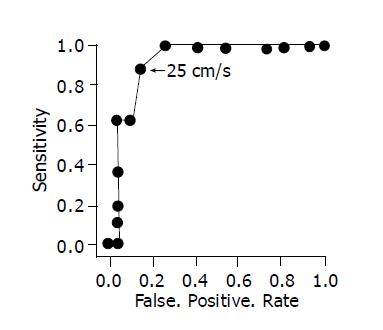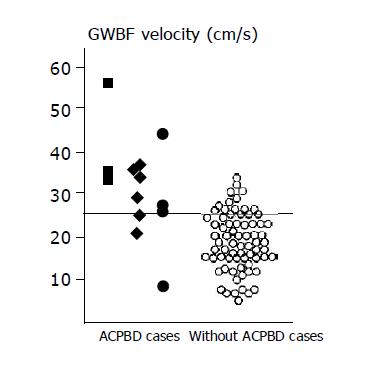Copyright
©2005 Baishideng Publishing Group Inc.
World J Gastroenterol. Feb 21, 2005; 11(7): 1018-1022
Published online Feb 21, 2005. doi: 10.3748/wjg.v11.i7.1018
Published online Feb 21, 2005. doi: 10.3748/wjg.v11.i7.1018
Figure 1 Receiver operating characteristic curve.
The cut-off level of the gallbladder wall blood flow velocity was set at 25 cm/s for diagnosing anomalous connection in pancreatobiliary disease.
Figure 2 Distribution of individual GWBF velocity (prospective study) Gallbladder wall blood flow velocities in the prospective study.
Using a 25 cm/s cut-off level in the retrospective study, 28 cases (13 with ACPBD cases and 15 without ACPBD cases) had a peak wall flow velocity of over 25 cm/s. ■, carcinoma with ACPBD; ◆, hyperplasia with ACPBD; •, adenomyomatosis with ACPBD; ○, without ACPBD; GWBF, gallbladder wall blood flow; ACPBD, anomalous connection in pancreatobiliary disease.
Figure 3 Case with gallbladder hyperplasia with ACPBD.
A: Gallbladder wall thickening was observed by gray-scale ultrasound; B: Color Doppler ultrasound revealed abundant blood flow within the hypertrophic gallbladder wall close to the hepatic bed. The peak gallbladder wall blood flow velocity was 44.2 cm/s by fast Fourier transform analysis of blood flow; C: Endoscopic ultrasonography shows the pancreatic duct (PD) and bile duct (BD) connection (arrow head) beyond the duodenal wall and within the pancreatic parenchyma. This is one of the cases with ACPBD detected in the prospective study (ACPBD, anomalous connection in pancreatobiliary disease).
- Citation: Kawashima H, Hirooka Y, Itoh A, Hashimoto S, Itoh T, Hara K, Kanamori A, Ohmiya N, Niwa Y, Goto H. Use of color Doppler ultrasonography in the diagnosis of anomalous connection in pancreatobiliary disease. World J Gastroenterol 2005; 11(7): 1018-1022
- URL: https://www.wjgnet.com/1007-9327/full/v11/i7/1018.htm
- DOI: https://dx.doi.org/10.3748/wjg.v11.i7.1018











